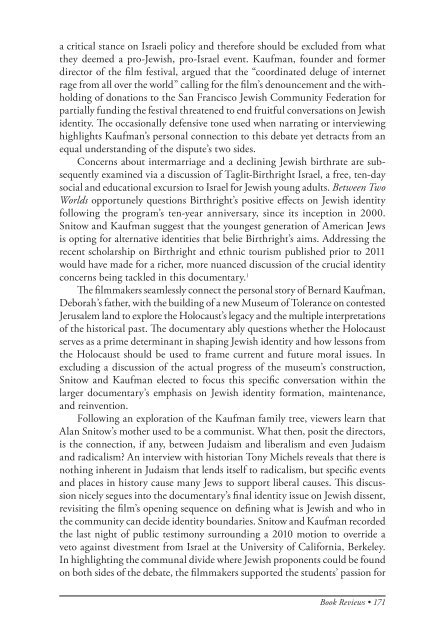American Jewish Archives Journal, Volume 64, Numbers 1 & 2
American Jewish Archives Journal, Volume 64, Numbers 1 & 2
American Jewish Archives Journal, Volume 64, Numbers 1 & 2
Create successful ePaper yourself
Turn your PDF publications into a flip-book with our unique Google optimized e-Paper software.
a critical stance on Israeli policy and therefore should be excluded from what<br />
they deemed a pro-<strong>Jewish</strong>, pro-Israel event. Kaufman, founder and former<br />
director of the film festival, argued that the “coordinated deluge of internet<br />
rage from all over the world” calling for the film’s denouncement and the withholding<br />
of donations to the San Francisco <strong>Jewish</strong> Community Federation for<br />
partially funding the festival threatened to end fruitful conversations on <strong>Jewish</strong><br />
identity. The occasionally defensive tone used when narrating or interviewing<br />
highlights Kaufman’s personal connection to this debate yet detracts from an<br />
equal understanding of the dispute’s two sides.<br />
Concerns about intermarriage and a declining <strong>Jewish</strong> birthrate are subsequently<br />
examined via a discussion of Taglit-Birthright Israel, a free, ten-day<br />
social and educational excursion to Israel for <strong>Jewish</strong> young adults. Between Two<br />
Worlds opportunely questions Birthright’s positive effects on <strong>Jewish</strong> identity<br />
following the program’s ten-year anniversary, since its inception in 2000.<br />
Snitow and Kaufman suggest that the youngest generation of <strong>American</strong> Jews<br />
is opting for alternative identities that belie Birthright’s aims. Addressing the<br />
recent scholarship on Birthright and ethnic tourism published prior to 2011<br />
would have made for a richer, more nuanced discussion of the crucial identity<br />
concerns being tackled in this documentary. 1<br />
The filmmakers seamlessly connect the personal story of Bernard Kaufman,<br />
Deborah’s father, with the building of a new Museum of Tolerance on contested<br />
Jerusalem land to explore the Holocaust’s legacy and the multiple interpretations<br />
of the historical past. The documentary ably questions whether the Holocaust<br />
serves as a prime determinant in shaping <strong>Jewish</strong> identity and how lessons from<br />
the Holocaust should be used to frame current and future moral issues. In<br />
excluding a discussion of the actual progress of the museum’s construction,<br />
Snitow and Kaufman elected to focus this specific conversation within the<br />
larger documentary’s emphasis on <strong>Jewish</strong> identity formation, maintenance,<br />
and reinvention.<br />
Following an exploration of the Kaufman family tree, viewers learn that<br />
Alan Snitow’s mother used to be a communist. What then, posit the directors,<br />
is the connection, if any, between Judaism and liberalism and even Judaism<br />
and radicalism? An interview with historian Tony Michels reveals that there is<br />
nothing inherent in Judaism that lends itself to radicalism, but specific events<br />
and places in history cause many Jews to support liberal causes. This discussion<br />
nicely segues into the documentary’s final identity issue on <strong>Jewish</strong> dissent,<br />
revisiting the film’s opening sequence on defining what is <strong>Jewish</strong> and who in<br />
the community can decide identity boundaries. Snitow and Kaufman recorded<br />
the last night of public testimony surrounding a 2010 motion to override a<br />
veto against divestment from Israel at the University of California, Berkeley.<br />
In highlighting the communal divide where <strong>Jewish</strong> proponents could be found<br />
on both sides of the debate, the filmmakers supported the students’ passion for<br />
Book Reviews • 171
















